My first brush with the art of lutherie over two decades ago began with a simple curiosity – what were all those parts on a guitar? Why were they there? From that moment, I embarked on an incredible journey to explore the anatomy of a guitar, crossing the boundaries of names and labels into the realm of soulful intricacies.
I’ve often marveled at how one could create such an incredible symphony twisting the strings, adjusting the bridge or tweaking the knobs, not really knowing why it works but delighting in the results. I’ve come to realize that the heart of this magic lies in understanding the intricacies of guitar anatomy. The labeled parts of a guitar aren’t just terms to memorize; they form the beautiful, intricate blueprint of an instrument that, when understood, can take your performance to an entirely new level.
In this comprehensive guide, I bring to life the labyrinthine world of guitar anatomy, unraveling the mysteries of labeled guitar parts. As one of your trusted guitar learning resources, this exploration aims not just to identify and label, but to delve into an understanding of how each intricate part of a guitar contributes to the music that thrills us. Surprisingly, or perhaps not, understanding these details often becomes an essential lifelong companion for any serious guitar enthusiast.
Every journey starts with a single step. In this case, the journey to understand guitar anatomy starts with a profound realization – the real power of a guitarist lies in how well one knows their guitar, right down to the smallest screw or tightest wind of a string… the discovery, of course, begins here. Join me as we dive into the world of guitar anatomy, hand in hand.
The Body
Acoustic vs Electric
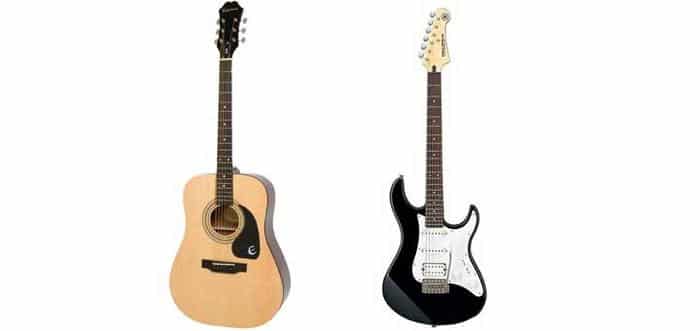
Having worked extensively with both acoustic and electric guitars, my experience gives me a unique perspective on their construction and the specific purpose of each component. Understanding the differences between these two types of guitars can provide valuable insights into their unique characteristics and functionality.
Starting with the acoustic guitar components, the body is primarily made of wood and is hollow, allowing it to act as a resonance chamber. Its primary components include the top (also known as the soundboard), the back and sides, and the soundhole. The materials used to construct these components, as well as their shape and size, can significantly affect the instrument’s tone.
In contrast, the electric guitar anatomy is quite different. Electric guitars have a solid body, and while they also have a top, back and sides, these are not used for resonance like they are in acoustic guitars. In an electric guitar, the strings’ vibration is converted into electrical signals by the pickups, which are then sent to an amplifier. Thus, the body’s primary function is to provide mass and support to the neck and bridge, aspects that can influence the sustain and tone of the guitar.
Acoustic guitars typically have a wider body, which can result in a fuller, more open sound compared to the tighter, more focused tones of electric guitars. The construction, wood type, and even the finish of the body can significantly impact an instrument’s tone, resonance, and sustain. For example, spruce tops are popular in acoustic guitars for their bright, vibrant tones, whereas mahogany and alder bodies are common in electric guitars for their balanced, warm tones.
On a fundamental level, an acoustic guitar’s body can be seen as its own amplifier, with the soundhole acting as the speaker, projecting the sound outwards. On the other hand, an electric guitar’s body acts as a substrate for the hardware and electronics, with no need for a soundhole or resonating chamber as the amplification is carried out externally.
As we delve deeper into other components like the neck, the fretboard, the headstock, and the unique extras exclusive to electric guitars, the contrast becomes even more compelling. But it’s interesting to note how both operate on the principle of strings vibration over a body, resulting in music that can profoundly touch hearts. It’s these subtle and complex variations in the acoustic and electric guitar anatomy that lead to the diverse spectrum of tones and sounds we enjoy in modern music.
To sum up, both acoustic and electric guitars have unique designs and components that cater to different musical genres and playing styles, reflecting the adaptable and diverse nature of the guitar as an instrument. Having a solid understanding of the differences and similarities between the structure of an acoustic and an electric guitar can be a key factor in choosing the right instrument for your needs and ensuring it is maintained correctly.
The Neck
The Role of the Fretboard
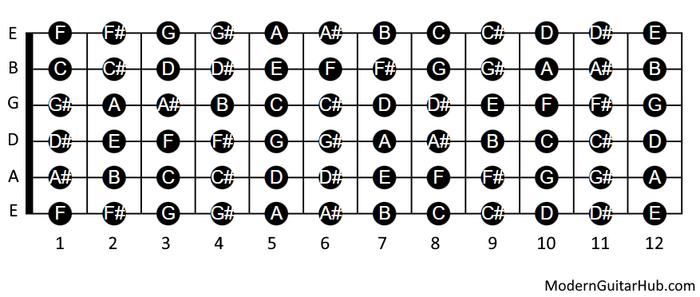
A crucial subsection of ‘The Neck’ in our discussion on the anatomy of a guitar is indisputably the fretboard. Having made fretboards from a wide range of tonewoods, I can elucidate on the crucial role it plays in both the aesthetics and functionality of a guitar. You might more familiarly recognize the guitar fretboard by its other names – fingerboard, or simply ‘the board’.
The fretboard can be seen as a canvas upon which the melody of a song is carefully crafted. Each distinct note produced when a guitar string is pressed against a fret originates from the fretboard. Moreover, the guitar fretboard isn’t just functional, it positively contributes towards the guitar’s outward appearance, and significantly impacts playability and tone.
To that end, the choice of material for the fretboard—frequently rosewood, ebony, or maple—is essential. Each wood type contributes to a unique feel and sound, thus one’s chosen style and genre of music may influence their preference. For instance, ebony fretboards provide a bright, snappy tone perfect for hard rock and heavy metal, while rosewood offers a warmer, more rounded sound, favored in blues and jazz.
Visibly, the fretboard presents an array of guitar parts names you might have heard. Along the length of the fretboard, you’ll see metal strips. These are ‘frets’ —critical for changing the pitch of a string. At the intersection of the frets and the strings are where fingers apply pressure to create distinct notes. Learning the precise placement of each fret can significantly elevate your understanding and musical skill.
In conclusion, the fretboard is a critical element of the guitar anatomy. It heavily influences the sound, playability, and visual appeal of the instrument. Moreover, understanding the fretboard equips you with greater knowledge to manipulate the sounds, thus expanding your mastery of this remarkable instrument. As we navigate down the neck, the next aspect we explore is the headstock. A seemingly simple part, yet instrumental in our journey of understanding the guitar.
The Headstock

As a craftsman working meticulously to fine-tune the anatomy of the guitar, I’ve found headstocks to be an indispensable part of the instrument that many musicians and guitar lovers tend to underestimate. The headstock, located at the far end of the neck opposite to the body, serves as the home to your tuning pegs. It might appear as just a simple piece of wood, but it’s so much more than that. Just like the different chords that evoke different feelings, different shapes, and sizes of the headstock have their unique implications.
Can the design of a guitar’s headstock influence its sound and tuning stability? These insights might change how you view this often-overlooked part of your instrument. Within their wooden casings, tuning pegs silently work their magic. While their function might seem limited to tightening or loosening the strings, they actually play a significant role in adjusting the pitch of the strings and maintaining the guitar’s overall tuning stability. This often overlooked component is the neck’s anchor and a critical determinant of the instrument’s sound.
Connection and harmony between different parts of a guitar are crucial for achieving the desired sounds. Much like tuning pegs, the nut too has a vital function rooted at the intersection of the headstock and the fretboard. It’s through the finely cut slots of the nut that the strings run, aiding in maintaining consistent pitch while playing, and influencing the guitar’s intonation. The overall design and material of the headstock, and the arrangement of tuning pegs affect how these vibrations generate harmonic overtones. This synergistic conjunction within the headstock is fascinating and yet often misunderstood.
To many, the headstock is a signature, a hallmark of a brand. But there’s a lot that goes behind those logos and ornate designs. Through my evolving journey as a guitar maker, the understanding and knowledge I’ve gained for different headstock designs have deeply influenced my craft. Subtle variations in the headstock can create a noticeable difference in a guitar’s sustain and tone. Even the angle at which the headstock tilts back from the neck affects string tension and transfer of energy. This, in turn, impacts sound transmission and tonal qualities. It’s this integrated play of details that lend each guitar its unique identity and voice.
So next time you pick up a guitar, I invite you to pay a little more attention to the headstock. It’s not just a display for a brand. It’s a marvelous piece of engineering that works in concert with the rest of your guitar to contribute to each note’s pitch, tone and resonance you play.
As we move forward in the coming chapters, we’ll delve deeper into various parts which may seem trivial but are critical to your guitar’s overall performance. Together, in understanding guitar anatomy, we are exploring a symphony of chords that bind the soul of a musician to the heart of an instrument.
Electronics
Extras for Electric Guitars
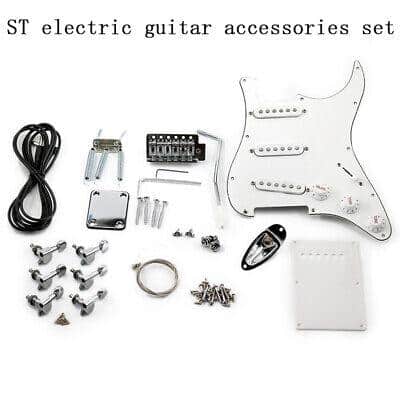
Continuing our journey through the anatomy of the guitar, we veer off the beaten path to explore some of the unique extras that bring an added layer of versatility to electric guitars. Throughout my career, I’ve experimented with various guitar hardware additions, including the thrilling whammy bar, and I’m excited to delve into these extras to share how they can enhance your play.
Let’s begin with the whammy bar — an exciting extra that adds so much to the playing experience. Officially known as a tremolo arm, the whammy bar allows the player to manipulate the pitch up or down by creating a wavering or bending sound known as a vibrato. This small metal bar attached to the bridge can be nudged or pulled to create pitch bends from subtle nuances to dramatic dives. Put simply, wielding a whammy bar is like having superpowers at your fingertips, let’s you animate sounds out of your electric guitar like you’re controlling a vocal choir.
However, the whammy bar is just the tip of the iceberg when it comes to electric guitar extras. From alternate tuning pegs that can instantly reconfigure your guitar’s tuning, to effects pedals that can morph your sound into anything from a thundering wall of distortion to a cascading waterfall of reverb, the world of guitar hardware is vast and varied. Bear in mind, though, that not all extras will fit or work with every guitar. It’s important to make informed choices when considering these enhancements, considering both your guitar and your personal sound.
In closing, while we often focus on the innate, structural elements of the guitar, the optional extras available for electric guitars broaden the horizon of your playing experience. They take your sound and creativity to new heights, cementing the loyal alliance between electric guitars and evolving technology. As we next transition into exploring other important parts of the guitar, remember that these “bonuses” are not to be overlooked; they are instrumental in shaping a guitar’s character, just like the core elements we’ve discussed.
Other Important Parts
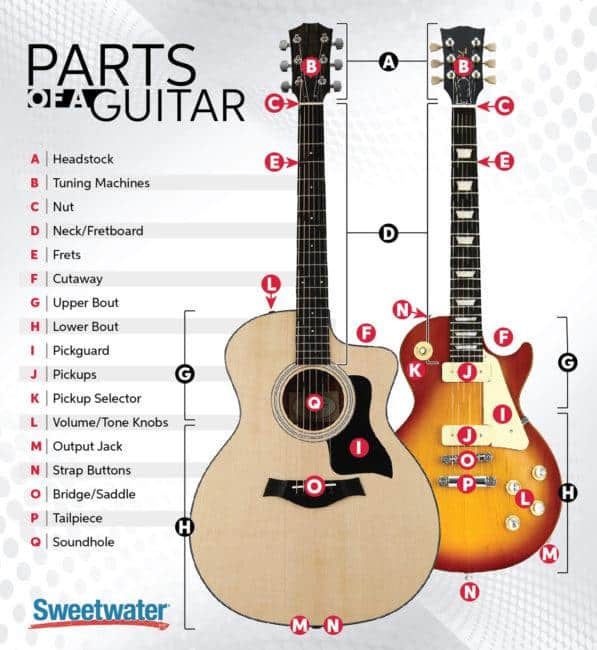
As with any complex piece of machinery, the functionality and performance of a guitar rely on a symphony of parts, each playing their integral role within the construction. In my many years of obsessing over every facet of these magical instruments, I’ve come to understand their remarkable intricacies and appreciate their inherent harmony. Each part of a classical guitar, every nut, bolt, and string, contributes to its sound, personality, and playability.
Guitar strings and even the smallest parts of a guitar hold remarkable stories that mold its character. Discover the significance of these overlooked components. Beyond the overarching frame, bridge, neck, and electronics lies an underworld of important components that might not get the spotlight but are just as essential in making a guitar sing.
The toughness of your guitar strings, the design of your tuning pegs, the width of your guitar’s nut, or even the materials used in the construction, each impact the tonal quality, resonance, and sustain that make every guitar indisputably unique. The sum of these parts, as they say, is far greater than the whole. Herein lies the beauty of a guitar’s anatomy.
One of the most crucial parts of a guitar is something you probably touch every time you play – the guitar strings. However, the depth of their importance is usually overlooked. The strings dictate the tension across the neck, influencing the guitar’s playability and tonal properties. The thickness, composition, and age of the strings can dramatically affect the sound of a guitar, making this aspect of guitar construction an essential piece of the puzzle.
Similarly, the guitar’s nut and saddle, often made from bone, plastic, or brass, play crucial roles in intonation and tone. These small parts, fixed at the top and bottom of the guitar string, not only keep string spacing consistent but also contribute to the overall resonance of the instrument by influencing the strings’ vibration.
In a similar vein, the endpin, a small cylindrical piece at the bottom of the body, supports the guitar strap, but also plays a role in acoustic resonance in instruments fitted with an end pin jack. Its material – often wood, metal or synthetic – can subtly impact the tone of the guitar.
There are more such elements, each unique and unassuming, stealthily contributing to the guitar’s voice. I’ve come to discover that these smaller parts of a guitar don’t receive the adulation they deserve, yet they shape every melody and chord progression we elicit from our instruments.
In the world of guitars, every detail matters. No part is too small, no function too insignificant. Understanding the anatomy of your guitar is not just about studying its physical components. It’s also about appreciating the craftsmanship behind it, the science that shapes its sound, and the stories each part holds within.
As you venture deeper into your journey with the guitar, I hope this comprehensive guide provides you with a greater appreciation and understanding of each component’s role, from the most visible to the most overlooked. May your newfound knowledge encourage you not just to play, but to connect deeply with your instrument, understanding the heart and soul behind its melody.
Maintenance and Setup
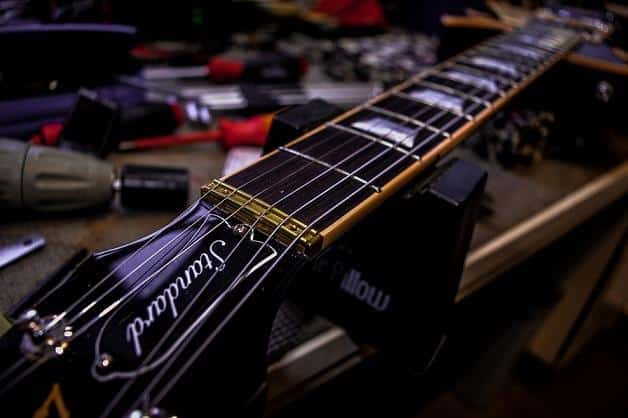
Having set up many guitars for professional musicians, I can give you some insider tips about maintaining the quality of your guitar and setting it up for the best performance. We’ve explored every nook and cranny of this fascinating instrument—the body, the neck, the headstock, the minute technicalities of electronics, and the extras for electric guitars. We’ve uncovered the role of the fretboard and the functionality of other important parts. Now, let’s delve into some integral components of guitar anatomy that often get overlooked—maintenance and setup.
Guitar maintenance—If you ask me, it’s the backbone of your instrument’s longevity and performance quality. The phrase ‘a well-oiled machine’ comes to mind; a guitar needs regular TLC to function at its best. Dust and grime are your guitar’s enemies—they can increase fret wear and impact tone quality over time. Hence, thoroughly cleaning the fretboard and body after each use could do wonders in maintaining the pristine condition of your guitar.
Want to keep your guitar sounding and playing great? Well, humor me for a bit. I’ve seen musicians treating their instruments like sacred relics, and there’s wisdom in that. Frequent string changing is a small act you can get into, and trust me, it has huge payoffs. Depending on your playing frequency, changing strings every one to three months is a good rule of thumb. This simple act can ensure that your guitar sound is always bright and clear, rather than becoming dull and lackluster over time due to worn-out strings.
Now, I know that the term ‘guitar setup‘ might sound all technical and daunting. But in reality, it’s all about making minor adjustments to your guitar to optimize playability and sound. It includes tweaking things like the string height, truss rod, and intonation. I’d be lying if I said that this doesn’t require a level of precision and expertise—it does, but with a bit of practice, it’s conquerable territory. Remember, just like the human body, every guitar is unique, and what works for one may not work for the other. Apply this understanding to your own instrument to appreciate and harness its unique qualities.
As we speak, I can’t help but remember the time I set up my favorite Stratocaster. Crafting the perfect balance between the string height and intonation was a mammoth task, but the result was well worth the effort. That guitar echoed with a bright tone and the ease of playability that I’d never experienced before. To put it simply, a well-maintained and correctly set up guitar not only delights the player but also charms the audience.
In the upcoming section, we address some recurring questions in the minds of guitar enthusiasts in our ‘FAQs’. So stay tuned and continue this enlightening journey of understanding your beloved guitar better. Remember, the goal is to form an intimate connection with your instrument, the kind that transforms your guitar from an object to an extension of yourself. It’s this connection that truly lets good music flow.
FAQs
What are the various parts of a guitar?
What is the function of the guitar neck?
Why are guitar frets important?
What is the role of a guitar’s body?
Conclusion
How has your perspective of your guitar changed through this journey? Whether it facilitated a newfound appreciation for its intricacies, or sparked a desire to delve deeper into its workings, that in itself is the beauty of understanding the anatomy of a guitar. No longer do the parts of a guitar appear as a complexity, but rather a tangible expression of music waiting to be explored.
Together, we’ve explored the body, delving into the distinctions between acoustic and electric guitars. We’ve familiarised ourselves with the neck, understood the vital role of the fretboard and ventured into the importance of the headstock. Stepping into the realm of electronics, we distilled the secrets held within electric guitars, examined those extras that enhance their sound and discovered other key elements integral to the overall instrument. Lastly, we touched upon critical aspects of maintaining and setting up your guitar, ensuring longevity and optimum performance.
With this comprehensive guide, I’ve sought to share my learnings and experiences from years of working, playing, and living with this incredible instrument. I hope that you have found these insights valuable, and that they will enrich your journey with your guitar.
Remember, understanding guitar anatomy is not a one-day process; it’s an ongoing process which keeps enriching with every note you play, every string you replace, and every scale you master. There are numerous guitar learning resources available, each offering a different perspective and depth of knowledge.
To tread this path means to constantly learn, adapt and grow, just as an instrumentalist does. It’s a journey of discovery as unique as the melodies you’ll play. Here’s to our shared passion for this remarkable instrument, and the music it breathes into our lives.
